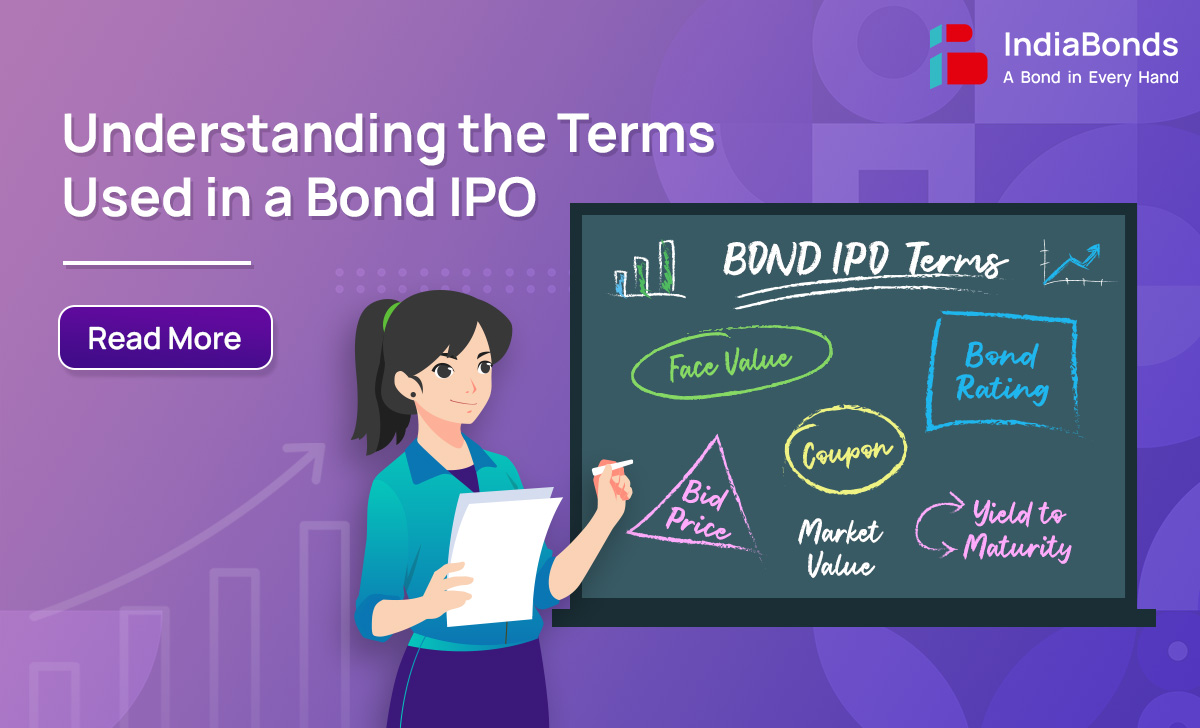Terms used in a Bond Public Issue (Bond IPO)

Introduction
A Bond Public Issue, also known as Bond IPO, is a process through which a company raises funds by issuing bonds to the public. In a Bond IPO, the issuer sets the terms of the bond, including the interest rate and maturity date, and sells the bonds to institutional and individual investors through a subscription process. One of the biggest benefits of investing in Bond Public Issue is that one can invest in bonds from as low as Rs. 10,000. Bonds are now a lucrative investment option for people looking to diversify their portfolio and find a better alternative to FDs or PPFs. In order to invest in such a public issuance, it’s important to get familiarized with the terms in Bond IPO.
Following are the key terms used in a Bond Public Issue:
1. Registrar
A registrar plays an important role in a Bond Public Issue. The registrar is a financial institution appointed by the issuer of the bonds to maintain the records of bondholders and perform various administrative tasks related to the issuance and maintenance of the bonds.
2. Debenture Trustee
A debenture trustee is an independent entity appointed by the issuer of bonds to act as a custodian of the bondholders’ interests. The debenture trustee plays an important role in a Bond Public Issue by ensuring that the terms and conditions of the bond issue are properly adhered to and that the rights of the bondholders are protected.
3. Lead Manager
The lead manager helps the issuer to bring the bonds to market and raising the necessary capital. The lead manager is typically a financial institution with expertise in bond underwriting and distribution.
4. Distributors/Broker
A distributor in a Bond Public Issue is a financial intermediary who helps to distribute the bonds to investors. The distributor is typically appointed by the lead manager of the bond issue to help market and sell the bonds to a wide range of investors.
5. Rating Agencies
The creditworthiness of a bond issuer is established by their credit rating. The credit rating is assigned by credit rating agencies such as CRISIL, ICRA or CARE, etc. These agencies use various financial metrics and factors, such as the issuer’s financial strength, debt-to-income ratio, and past credit performance, to determine the credit rating. To learn more about credit rating, click here.
6. Application Date
The application date refers to the date on which individuals or organizations submit their intent to purchase bonds during the public offering period. The Bond IPO process typically involves the issuance of new bonds by a company or PSU, which is then made available for purchase to the general public.
7. Issue Details
The issue details refer to the specific characteristics and terms of a bond offering. These details include information such as the face value of each bond, the coupon rate (the interest rate the bond will pay), the maturity date (the date on which the bond will reach maturity and the principal will be repaid), interest payment frequency and any special features such as callability or convertibility.
8. ASBA
ASBA stands for “Applications Supported by Blocked Amount” and is a mechanism for applying for shares or bonds in a public issue in India. Under the ASBA system, an applicant’s bank account is blocked for the amount that the applicant wishes to apply for in the public issue. This amount is only debited from the bank account after the allotment of shares or bonds is completed. This means that the applicant’s funds remain in their bank account and continue to earn interest until the allotment is completed. In the context of Bond Public Issues, investors can use the ASBA facility to apply for bonds and ensure that the necessary funds are available for allotment.




9. Tenor
The term “tenor” refers to the length of time until the bond reaches maturity. Tenor is a key feature of a bond issue and is typically defined in years.
10. Face Value
The face value of a bond is the minimum denomination or a unit which can be transacted. It is also the amount that the issuer will pay to the bondholder at maturity. For public issue of bonds the face value of each bond remains Rs. 1000.
11. Base Issue
The base issue size is the total amount of bonds that the issuer is offering for sale during the public offering. The size of the base issue can vary depending on the issuer’s financing needs and the overall demand for the bonds.
12. Allotment
Allotment refers to the process of distributing the bonds being offered for sale to the public during the public issue. Allotment involves determining the number of bonds that will be allotted to each individual investor. Allotment is set at a ‘first come, first serve’ basis.
13. Investor Categories
Participants in the bond public issue are typically categorized as follows:
A. Institutional Investors:
Banks & Financial Institutions, FIIs and FPIs, Mutual Funds, Insurance Companies.
B. Non – Institutional Investors:
Limited Liability Partnerships, Public and Private Charitable Trusts, Partnership Firms, Associations of People.
C. High Net worth Individuals:
Investors looking to invest more than INR 10 Lakhs across all options, Resident Indian Individuals, HUFs.
D. Retail Investors:
Investors looking to invest less than or up to INR 10 Lakhs across all options, Resident Indian Individuals, HUFs.
14. Interest Frequency
Interest frequency refers to the frequency at which interest payments are made on a bond. The interest frequency for a bond is specified in the bond’s offering documents and can be annual, semi-annual, or quarterly.
15. Product Note
Product note is a document that provides investors with information about the features and terms of a bond offering. The product note serves as a comprehensive guide to the bond, providing information about the issuer, the use of proceeds, the maturity date, the interest rate, the credit rating, and other important details.
16. Information Memorandum
Information Memorandum (IM) is a document that provides prospective investors with detailed information about the bond’s public issue. It includes information such as the issuer’s business and financial history, the terms of the bond offering, the risks associated with investing in the bond, the use of proceeds from the offering, and the management team.
17. Tranche
Tranches are frequently utilized to split up a huge debt offering into manageable chunks. This is done because the organization might have the requirement in a staggered manner as opposed to a lump sum approach since they might wish to evaluate the market climate, liquidity, and interest rate scenario before taking a bulk of investment all at once.
18. Coupon Rate
The coupon rate refers to the interest rate that is paid to bondholders on a periodic basis. The coupon rate is expressed as a percentage of the bond’s face value, and it determines the amount of interest that a bondholder will receive for each bond that they own.
19. Yield
The yield refers to the rate of return that an investor can expect to receive on a bond investment. The yield is expressed as a percentage of the bond’s face value, and it takes into account the coupon rate (the interest rate paid on the bond), as well as any changes in the market price of the bond.
Conclusion
Understanding the Bond IPO terms is essential for investors looking to participate in the bond market. Some important terms to consider include the bond’s coupon rate, maturity date, credit rating and any associated fees or expenses. It’s important to carefully evaluate these terms and do thorough research on the issuer before investing in a Bond IPO to make informed investment decisions.
Disclaimer: Investments in debt securities/ municipal debt securities/ securitised debt instruments are subject to risks including delay and/ or default in payment. Read all the offer related documents carefully.



















































